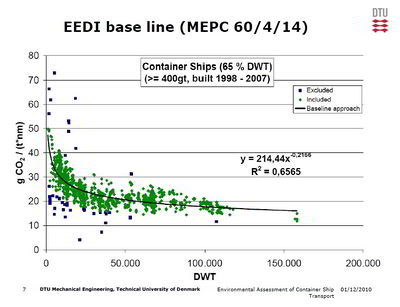Exhaust Emission Module
Introduction
At its 29th meeting, the IWRAP Steering Group decided that it would be useful if IWRAP could be be used for estimating the CO2 and other emissions from vessel movements within a given IWRAP model. Gatehouse agreed to develop a first version of such a plug-in module for IWRAP.
The purpose of this page is to collect resources and references useful for this development.
Energy Efficiency Design Index (EEDI)
Energy Efficiency Design Index is a measure of the CO2 efficiency of a ship.
The basic principle of EEDI is that it expresses the CO2 emissions per unit of the transport work of the ship.
IMO and the Energy Efficiency Design Index
The Energy Efficiency Design Index was made mandatory by the IMO for new ships and the Ship Energy Efficiency Management Plan (SEEMP) for all ships at MEPC 62 (July 2011) with the adoption of amendments to MARPOL Annex VI (resolution MEPC.203(62)), by Parties to MARPOL Annex VI.
This was the first legally binding climate change treaty to be adopted since the Kyoto Protocol. Since this breakthrough MEPC 63 (March 2012) adopted four important guidelines (resolutions MEPC.212(63), MEPC.213(63), MEPC.214(63) and MEPC.215(63)) aimed at assisting the implementation of the mandatory regulations on Energy Efficiency for Ships in MARPOL Annex VI.
DTU work on Energy Efficiency Design Index
Mr. Hans Otto Kristensen from the Danish Technical University (DTU) has done a lot of work on calculating EEDI based on vessel gross tonnage.
The first version of the IWRAP Emission module will be based on the work of Mr. Hans Otto Kristensen.
A PPT presentation on the DTU approach to calculating EEDI can be found here: File:101129 skibsfart hohk.pdf.
System for Calculating Exhaust Emissions in Finland
Markus Porthin from VTT in Finland provided this information to the IWRAP Steering Group: LIPASTO - a calculation system for traffic exhaust emissions and energy consumption in Finland. The system is developed by VTT Technical Research Centre of Finland.
Exhaust Emissions in Ice Conditions
Also from Markus Porthin: Calculation of CO, NOx, SOx, CO2, Particles, Fuel consumption as emissions per second (database from FMI), based on:
- Speed
- Ice thickness
- Ship type
- Assisted or not assisted
Section 5.2 of Innovative Icebreaking Concepts for Winter Navigation dealing with Gas Emissions.
